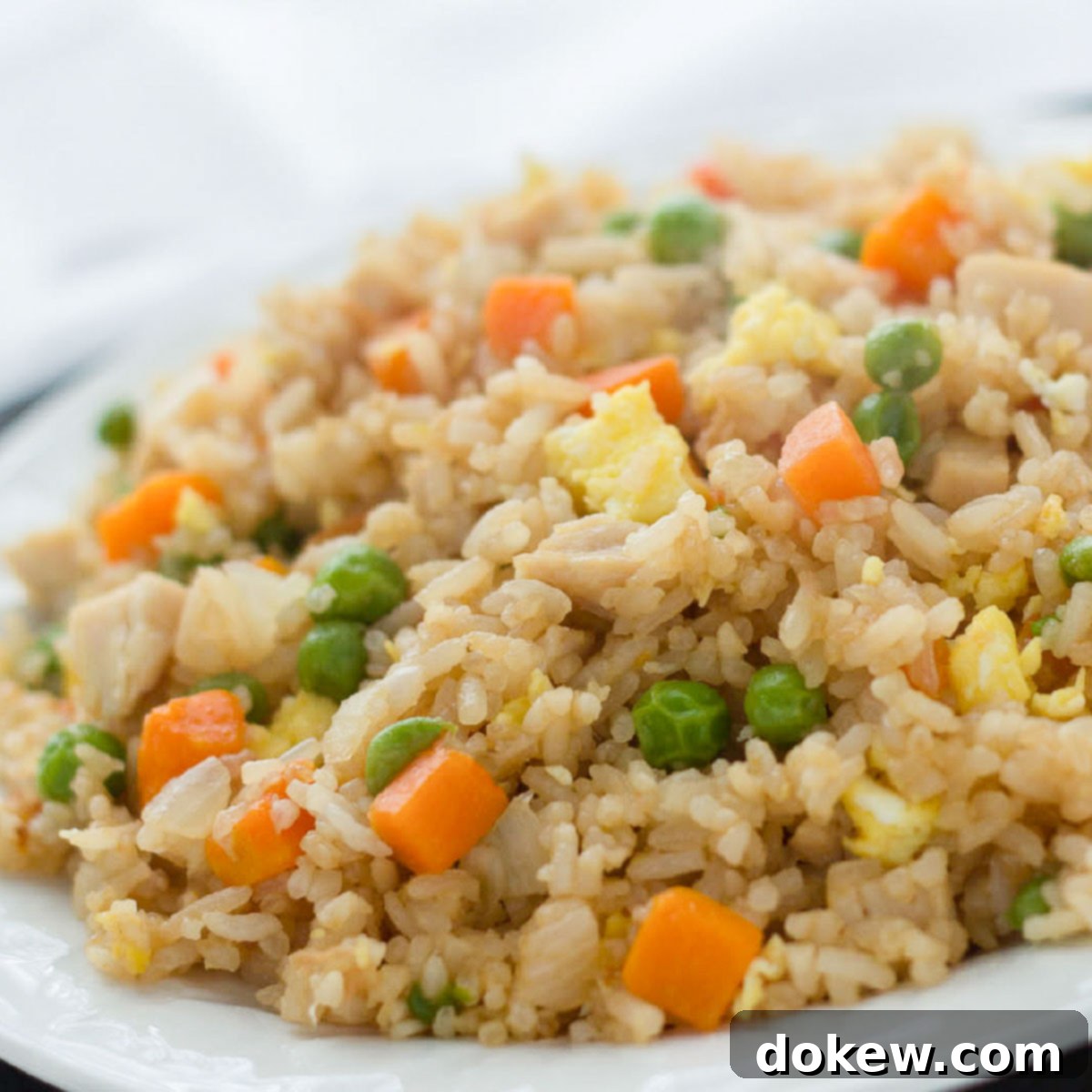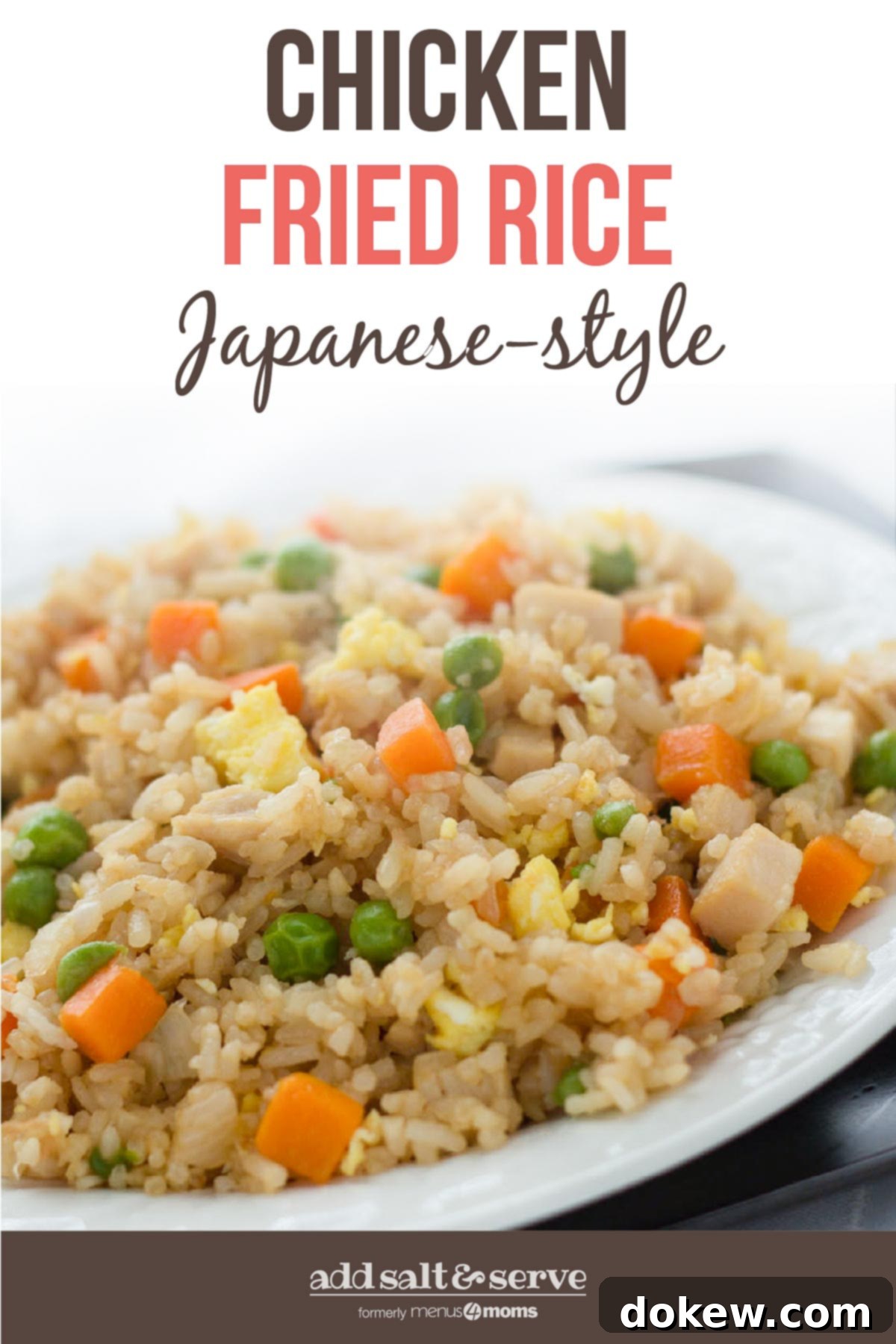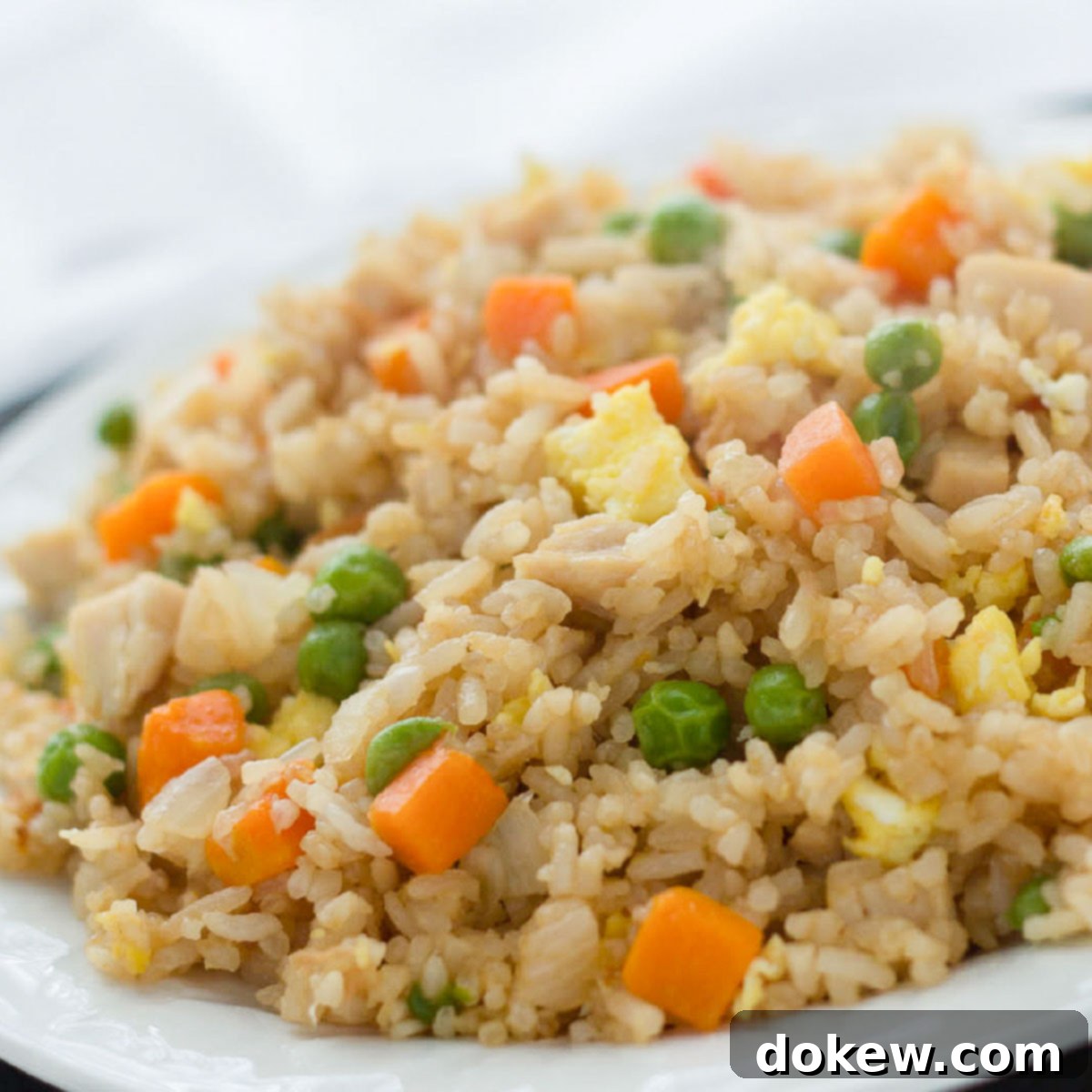Authentic Japanese Chicken Fried Rice: Easy Weeknight Meal & Leftover Hero
Embark on a culinary journey to Japan right from your kitchen with this authentic Chicken Fried Rice recipe. This isn’t just any fried rice; it’s a dish perfected through years of living and cooking in Japan, capturing the essence of a truly delicious and satisfying meal. Famous for its versatility and incredible flavor, fried rice is a beloved staple around the world, and this Japanese-style version stands out for its balanced taste and perfect texture.
Whether you’re looking for a quick and easy weeknight dinner, a fantastic way to use up those planned leftovers, or simply craving a taste of something genuinely authentic, this recipe is your go-to. It’s easily adaptable with almost any meat, such as shrimp or pork, or can be transformed into a vibrant vegetarian dish by simply adding more of your favorite vegetables. Prepare to impress your family and friends with a homemade fried rice that rivals your favorite takeout!

The Secret to Perfect Fried Rice: Why Day-Old Rice is Essential
One of the most crucial elements in achieving truly great fried rice, the kind that’s fluffy, separate, and slightly crispy, is using day-old, refrigerated rice. This might sound like a simple tip, but it’s the cornerstone of preventing mushy, clumpy fried rice. When rice is cooked, it absorbs water and becomes soft. If you try to stir-fry freshly cooked, warm rice, it will continue to steam and release moisture in the hot pan, leading to a soggy texture where the grains stick together.
Day-old rice, on the other hand, has had time to dry out in the refrigerator. The grains become firmer and less sticky, making them ideal for stir-frying. When introduced to a hot wok or skillet, these drier grains can crisp up beautifully without releasing excess moisture, allowing them to achieve that desirable individual, slightly chewy texture. For best results, spread your freshly cooked rice thinly on a baking sheet or plate and refrigerate it loosely covered for at least 6-8 hours, or preferably overnight. Before cooking, gently break apart any clumps with your hands or a fork to ensure even distribution in the pan.
Why You’ll Love This Japanese Chicken Fried Rice Recipe
- Authentic Flavor: Learned directly from Japanese culinary traditions, this recipe delivers a genuinely authentic taste experience.
- Quick & Easy: Perfect for busy weeknights, it comes together in under an hour, making dinner a breeze.
- Highly Customizable: Easily swap chicken for other proteins or load it with extra vegetables to suit your taste or dietary needs.
- Budget-Friendly: A brilliant way to repurpose leftover rice and cooked chicken, reducing food waste and saving money.
- Family-Friendly: A universally loved dish that even picky eaters will enjoy, making it a regular rotation in your meal plan.
🥘 Ingredients for Authentic Chicken Fried Rice
Gathering your ingredients beforehand is key to a smooth stir-frying process. Here’s what you’ll need for this delicious fried rice:
- Cold Leftover Cooked Rice: 3 cups (preferably medium-grain Calrose rice, broken apart). This is non-negotiable for the best texture!
- Egg: 1 large egg, for that classic fried rice richness and texture.
- Onion: 1 medium onion, finely chopped, providing aromatic depth.
- Frozen Peas and Carrots: 1 cup, thawed, adding color, sweetness, and essential nutrients.
- Cooked Chicken: 1 cup, chopped into bite-sized pieces. Leftover rotisserie chicken works wonderfully here.
- Soy Sauce: 1-2 tablespoons, to taste. Use a high-quality Japanese soy sauce for authentic flavor.
- Oil for Frying: 3-4 tablespoons (e.g., vegetable oil, canola oil, or a neutral oil with a high smoke point), divided for different stages of cooking.
🍲 Adaptations for Dietary Restrictions
This recipe is incredibly flexible and can be easily adjusted to fit various dietary needs:
- Vegetarian: To make a delicious vegetarian fried rice, simply omit the chicken. You can substitute it with extra vegetables like mushrooms, bell peppers, corn, or even firm tofu, pan-fried until golden.
- Gluten-Free: For a gluten-free version, ensure you use a certified gluten-free soy sauce or Tamari. Many standard soy sauces contain wheat, so checking the label is essential.
📋 Step-by-Step Instructions: How to Make Chicken Fried Rice
Making delicious fried rice at home is simpler than you might think. Follow these steps for a perfectly cooked, flavorful dish:
- Prepare Your Ingredients: Begin by taking 1 cup of frozen peas and carrots out to thaw. Finely chop your onion. If your chicken isn’t already in bite-sized pieces, chop it as well. Having everything prepped and ready to go (mise en place) is crucial for stir-frying.
- Scramble the Egg: Heat a teaspoon of oil in a wok or a large, flat griddle surface over medium-high heat. Once hot, quickly crack and scramble the egg in it until just cooked through but still soft. Remove the scrambled egg from the pan and set it aside. You’ll add it back in later.
- Sauté Aromatics: Add about 1 tablespoon of oil to the same pan and heat it until shimmering. Add the chopped onion and sauté for 2-3 minutes, stirring frequently, until it starts to become tender and translucent.
- Add Vegetables and Chicken: Incorporate the thawed peas and carrots along with the cooked chopped chicken into the pan. Stir gently to combine the ingredients, allowing them to heat through for a couple of minutes.
- Introduce the Rice: Once the onions are tender and the other ingredients are warm, add the 3 cups of cold, leftover cooked rice to the pan. Break apart any clumps of rice thoroughly before adding them to ensure even cooking and texture.
- Stir-Fry and Season: Stir the rice well, making sure all the grains are exposed to the heated surface of the pan. This helps to dry out the rice further and allows it to crisp up. Add 1-2 tablespoons of soy sauce, or adjust to your preferred taste. Continue to stir and mix vigorously, ensuring the soy sauce is evenly distributed and the rice grains are constantly moving. If the pan seems dry, add additional oil.
- Incorporate the Egg: Just before the end of the cooking time, return the scrambled egg to the pan. Use your spatula or spoon to chop it into smaller pieces and stir it thoroughly into the fried rice.
- Finish and Serve: Continue to stir-fry for a few more minutes until the rice is heated through and has developed a slightly crispy texture in places. Taste and adjust seasoning if necessary. Your authentic Japanese Chicken Fried Rice is now ready to serve!
💭 Pro-Tips for the Best Homemade Fried Rice
Achieving restaurant-quality fried rice at home is all about technique and a few key secrets:
- Choose the Right Rice: While you can technically use any cooked rice, the type does make a difference. I often use Calrose rice, a medium-grain variety known for releasing more starch during cooking than long-grain white rice. This makes the grains slightly stickier, which is delightful if you enjoy eating with chopsticks. However, long-grain white rice, jasmine rice, or basmati rice will also yield delicious results, so use what you have on hand and prefer.
- Rinse Your Rice (Before Initial Cooking): The secret to truly non-sticky, separate grains in your original cooked rice is to rinse it thoroughly before cooking. This removes excess surface starch, which can cause stickiness and contribute to mushiness in fried rice.
- Separate Rice Clumps: Before adding your day-old rice to the hot pan, make sure to crumble any large clumps. Using your hands to gently separate the grains ensures that each grain gets properly heated and seasoned, leading to a superior texture.
- High Heat is Your Friend: Fried rice needs high heat. Ensure your wok or skillet is very hot before adding ingredients, and try not to overcrowd the pan. Cooking in batches if necessary will prevent the temperature from dropping too much, which can lead to steaming rather than frying.
- Layering Flavors: Add your soy sauce gradually and taste as you go. You can also experiment with other seasonings like a dash of white pepper, a tiny pinch of sugar, or a touch of oyster sauce (if not making it vegetarian/vegan) for added depth.
- Don’t Forget the Yum Yum Sauce! If you want to add an extra layer of rich flavor (and some calories!), a splash of Yum Yum sauce (or Japanese white sauce) about halfway through cooking or as a drizzle at the end can elevate your fried rice to a new level of deliciousness.
- Finish with Sesame Oil: For an authentic aroma and nutty flavor, a small drizzle of toasted sesame oil right at the very end, just before serving, makes a huge difference. Add it off the heat to preserve its delicate flavor.
Customizing Your Chicken Fried Rice: Endless Variations
One of the best aspects of fried rice is its incredible flexibility. Once you have the basic technique down, you can truly make it your own:
- Protein Swaps:
- Shrimp Fried Rice: Sauté raw shrimp until pink and cooked through, then add it back with the chicken.
- Pork Fried Rice: Use leftover cooked pork (char siu is excellent!) or quick-cooking pork strips.
- Beef Fried Rice: Thinly sliced beef, stir-fried quickly, makes a hearty addition.
- Tofu Fried Rice: For a plant-based option, press extra-firm tofu, cube it, and pan-fry until crispy before adding.
- Vegetable Power-Up: Feel free to add more vegetables beyond peas and carrots. Try diced bell peppers, corn, mushrooms, cabbage, bean sprouts, or bamboo shoots. Add harder vegetables like bell peppers with the onion, and softer ones like bean sprouts closer to the end.
- Spicy Kick: For those who love heat, add a pinch of red pepper flakes or a drizzle of sriracha during cooking, or serve with chili garlic sauce on the side.
- Fresh Herbs & Garnish: Always finish with a sprinkle of freshly chopped green onions (scallions) for color and a fresh, mild onion flavor. Toasted sesame seeds also make a lovely garnish.
🍽️ Serving Suggestions
While Chicken Fried Rice is a complete meal on its own, it pairs wonderfully with a variety of side dishes to create a more elaborate feast. Consider serving it alongside:
- A simple miso soup
- Crispy gyoza or potstickers
- A fresh cucumber salad with a light vinaigrette
- Spring rolls or egg rolls
- Steamed edamame
Storage and Reheating
Leftover fried rice can be a delightful lunch the next day, but proper storage and reheating are important for both taste and safety.
- Storage: Allow any remaining fried rice to cool completely, then transfer it to an airtight container. Refrigerate promptly within two hours of cooking. It will keep well in the refrigerator for up to 3-4 days.
- Reheating: For best results, reheat fried rice in a hot pan or wok with a tiny bit of oil. Stir-fry it over medium-high heat until it’s heated through and some of the grains have re-crisped. You can also microwave it, though the texture might not be as crispy. Add a splash of water or soy sauce if it seems too dry when microwaving.
Frequently Asked Questions About Fried Rice
Can I use fresh rice for fried rice?
While technically possible, it’s highly recommended to use day-old, cold rice. Freshly cooked rice has too much moisture, which can lead to a mushy and sticky texture when stir-fried. If you must use fresh rice, spread it out on a baking sheet and let it cool completely, ideally for an hour in the freezer or several hours in the fridge, to help it dry out.
What kind of oil is best for fried rice?
A neutral oil with a high smoke point is ideal for stir-frying. Good options include vegetable oil, canola oil, grapeseed oil, or peanut oil. Olive oil is generally not recommended due to its lower smoke point and stronger flavor.
How do I prevent my fried rice from being mushy?
The main culprits for mushy fried rice are using fresh rice and overcrowding the pan. Always use day-old, cold rice that has been broken into individual grains. Cook in batches if your pan isn’t large enough to give the ingredients room to fry rather than steam. Also, ensure your pan is adequately hot throughout the cooking process.
What kind of chicken should I use?
Any leftover cooked chicken works perfectly! This could be rotisserie chicken, baked chicken breast, or even grilled chicken. Ensure it’s chopped into small, bite-sized pieces for easy mixing and eating.
Can I make it spicier?
Absolutely! You can add a pinch of red pepper flakes, a dash of chili oil, or a squeeze of Sriracha during the stir-frying process. Alternatively, serve with your favorite hot sauce on the side.
📌 Pin This Recipe for Later!
Don’t forget to save this delicious and authentic Japanese Chicken Fried Rice recipe for your next meal planning session. It’s a fantastic addition to any home cook’s repertoire, promising flavor, ease, and versatility.

